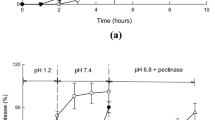Abstract
The major concern with the use of some synthetic excipients is their safety towards biological tissues, hence influencing the reliability of products. With the aim to minimize dependency on highly toxic synthetic excipients, the present study was designed to deliver metronidazole (MNZ) into the colonic region for localized treatment of amoebiasis using natural polysaccharide-based drug delivery. Compression-coated tablets were prepared using water extractable natural polysaccharide from Trigonella foenum-graecum (FG). Physical properties of the tablets were evaluated and dissolution study was performed at pH 1.2, 6.8, and 7.4 with rat cecal material. Results indicate that all batches demonstrated pH-dependent drug release and prevented release into the stomach, allowing traces into the intestine and highest availability into the colon. A significant correlation (r2 = 0.975) was found between the coating levels of extracted polysaccharide and lag time release of drug. Gamma scintigraphy images of in vivo study conducted on human volunteers showed a small intestinal transit time, i.e., 3–5 (4.2 ± 0.4) h and confirmed that the tablets reached the colon within 6–8 h. The present study revealed that the FG polysaccharide-based double compression tablets may be promising colon-specific drug carriers with reduced toxic effects of commonly used synthetic excipients.



Similar content being viewed by others
References
Krishnaiah YSR, Reddy PRB, Satyanarayana V, Karthikeyan RS. Studies on the development of oral colon targeted drug delivery systems for metronidazole in the treatment of amoebiasis. Int J Pharm. 2002;236:43–55.
Ansari MF, Siddiqui SM Agarwal SM, Vikramdeo KS, Mondal N, Azam A. Metronidazole hydrazone conjugates: design, synthesis, antiamoebic and molecular docking studies. Bioorg Med Chem Lett. 2015;25:3545–9.
Bendesky A, Menendez D, Wegman PO. Is metonidazole carcinogenic. Mutat Res Rev Mutat Res. 2002;511:133–14.
Venkata SM, Sreenivasa RN, Ambedkar SS, Venkata RMK. Charaterization and in-vitro drug release studies of a natural polysaccharide terminalia catappa gum (badam gum). AAPS PharmSciTech. 2012;13:1451–64.
Sharma BG, Kumar N, Nishad DK, Khare NK, Bhatnagar A. Development of microbial trigger based oral formulation of metronidazole and its gamma scintigraphy evaluation: a promising tool against anaerobic microbes associated GI problems. Eur J Pharm Sci. 2016;30:94–104.
Kavianiniaa I, Pliegera PG, Caveb NJ, Gopakumarb G, Dunowskab M, Kandilec NG, et al. Design and evaluation of a novel chitosan-based system for colon-specific drug delivery. Int J Biol Macromol. 2016;85:539–46.
Shun YL, Ayres JW. Calcium alginate beads as core carriers of 5-aminosalicylic acid. Pharm Res. 1992;9:714–90.
Bharaniraja B, Kumar KJ, Prasad CM, Sen AK. Different approaches of katira gum formulations for colon targeting. Int J Biol Macromol. 2011;49:305–10.
Chena SC, Wua YC, Mib FL, Lin YH, Yua LC, Sung HW. A novel pH-sensitive hydrogel composed of N,O-carboxymethyl chitosan and alginate cross-linked by genipin for protein drug delivery. J Control Release. 2004;96:285–300.
Krishnaiah YSR, Satyanarayana V, Kumar BD, Karthikeyan RS, Bhaskar P. In vivo pharmacokinetics in human volunteers: oral administered guar gum-based colon-targeted 5-fluorouracil tablets. Eur J Pharm Sci. 2003;19:355–62.
Dutta R, Bandyopadhyay AK. A new nasal drug delivery system of diazepam using fenugreek. J Sci Ind Res. 2005;64:973–7.
Nayak AK, Pal DK, Santra K. Screening of polysaccharides from tamarind, fenugreek and jackfruit seeds as pharmaceutical excipients. Int J Biol Macromol. 2015;79:756–60.
Tyagi S, Sharma N, Gupta SK, Sharma A, Bhatnagar A, Kumar N, et al. Development and gamma scintigraphical clearance study of novel hibiscus rosasinensis polysaccharide based mucoadhesive nasal gel of rizatriptan benzoate. J Drug Deliv Sci Technol. 2015;30:100–6.
Klein S, Rudolph MW, Dressman JB. Drug release characteristics of different mesalazine products using USP apparatus 3 to simulate passage through the GI tract. Dissolut Technol. 2002;9:6–12. https://doi.org/10.14227/DT090402P6.
Newton AMJ, Indana VL, Kumar J. Chronotherapeutic drug delivery of tamarind gum, chitosan and okra gumcontrolled release colon targeted directly compressed propranolol HCl matrix tablets and in-vitro evaluation. Int J Biol Macromol. 2015;79:290–9.
Pharmacopoeia, U.S. USP29-NF 24. Rockville: USP; 2005.
Launay B, Doubiler I, Cavalier G. Flow properties of aqueous solution and dispersions of polysaccharides. In: Mitchell JA, editor. Functional properties of food macromolecules. New York: Elsevier Applied Sciences Publishers; 1985. p. 601.
Mamani PL, Ruiz-Caro R, Veiga MD. Pectin/anhydrous dibasic calcium phosphate matrix tablets for in vitro controlled release of water-soluble drug. Int J Pharm. 2015;494:235–43.
Junginger HE, Verhoef JC, Thanou M. Drug delivery: mucoadhesive hydrogels. In: Swarbrick J, editor. Encyclopedia of pharmaceutical technology. New York: Informa Healthcare; 2009. p. 1169–82.
You YC, Dong LY, Dong K, Xu W, Yan Y, Zhang L, et al. In vitro and in vivo application of pH-sensitive colon-targeting polysaccharide hydrogel used for ulcerative colitis therapy. Carbohydr Polym. 2015;130:243–53.
Nasa P, Mahant S. Floating drug delivery system using methocel K100M and E50: formulation and characterization. Acta Pharm Suec. 2011;53:57–65.
Kumar N, Soni S, Singh T, Kumar A, Ahmad FJ, Bhatnagar A, et al. Development and optimization of gastro retentive controlled release tablet of calcium disodium edenatate and its invivo gamma scintigraphic evaluation. AAPS PharmSciTech. 2015;16:1270–80.
Acknowledgements
We are highly thankful to the Institute of Nuclear Medicine and Allied Sciences (INMAS), New Delhi, for providing basic technical and instrumental support.
Author information
Authors and Affiliations
Corresponding author
Ethics declarations
The protocol was approved by the institutional human ethical committee (vide no: IEC/INM/15-16/1-13) and prior written consent of human volunteers was taken.
Rights and permissions
About this article
Cite this article
Sharma, N., Sharma, A., Nishad, D.K. et al. Development and Gamma Scintigraphy Study of Trigonella foenum-graecum (Fenugreek) Polysaccharide-Based Colon Tablet. AAPS PharmSciTech 19, 2564–2571 (2018). https://doi.org/10.1208/s12249-018-1066-4
Received:
Accepted:
Published:
Issue Date:
DOI: https://doi.org/10.1208/s12249-018-1066-4




